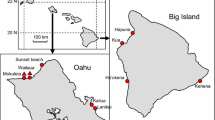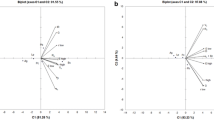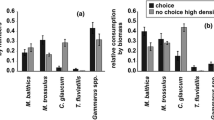Abstract
The maximum population density of the burrowing anemone (Ceriantheopsis americanus) was estimated at 17–28 animals m−2 in soft-bottom sediments of mid Narragansett Bay. The gut contents of the anemone indicated primary prey of harpacticoid and calanoid copepods. The consumption of calanoid copepods was higher in October than April, which may be due to decreased density of hapacticoids in the fall. The anemones apparently avoid fish predation in late summer by withdrawing into the sediments. After the seasonal fall migration of fish out of the bay, anemones reappear.
Similar content being viewed by others
Literature Cited
Bigelow, H. B. and W. C. Schroeder. 1953. Fishes of the Gulf of Maine.Fish Wildlife Service, Fish Bulletin 53.
Bowman, R. E. andW. L. Michaels. 1984. Food of seventeen species of northwest atlantic fish. National Oceanic and Atmospheric Administration Technical Memorandum 28. National Marine Fisheries Service, Woods Hole, Massachusetts.
Durbin, A. G. andE. G. Durbin. 1981. Standing stock and estimated production rates of phytoplankton and zooplankton in Narragansett Bay, Rhode Island.Estuaries, 4:24–41.
Eleftheriou, A. andD. J. Basford. 1983. The general behavior and feeding ofCerianthus Ilyodi Gosse (Anthozoa, Colenterta).Cahiers De Biologie Marine 24:147–158.
Fishelson, L. 1970. Littoral fauna of the Red Sea: The population of non-scleractinian anthozoans of shallow water of the Red Sea (Eilat).Marine Biology 6:106–116.
Friedland, K. D., G. C. Gorman, A. J. Bejda, A. L. Studholme, andB. Olla. 1988. Interannual variation in diet and condition in juvenile bluefish during estuarine residency.Transactions of the American Fisheries Society 117:474–479.
Gosner, K. L. 1979. A Field Guide to the Atlantic Seashore. Houghton Mifflin Co., Boston, Massachusetts.
Jeffries, H. P. andW. C. Johnson. 1974. Seasonal distributions of bottom fishes in the Narragansett Bay area: Seven-year variations in the abundance of winter flounder (Pseudopleuronectes americanus).Journal of the Fisheries Research Board of Canada 31: 1057–1066.
Kendall, A. W. 1977. Biological and fisheries data on black sea bass,Centropristis striata (Linnaeus). National Oceanic and Atmospheric administration Technical Series Report 7. National Marine Fisheries Service, Sandy Hook, New York.
McMaster, R. L. 1984. Holocene stratigraphy and depositional history of the Narragansett Bay system, Rhode Island.Sedimentology 31:777–792.
Maurer, R. O. Jr. and R. E. Bowman. 1975. Food Habits of Marine Fishes of the Northwest Atlantic. National Oceanic and Atmospheric Administration. National Marine Fisheries Service, Laboratory Reference 75-3. Woods Hole, Massachusetts.
Michelman, M. S. 1988. The biology of juvenile scup. Master’s Thesis. The University of Rhode Island, Kingston, Rhode Island.
Murawski, S. A., D. G. Frank, andS. Chang. 1978. Biological and fisheries data on butterfish,Peprilus triacanthus (Peck). National Oceanic and Atmoispheric Administration Technical Series Report 6. National Marine Fisheries Service, Sandy Hook, New York.
Oviatt, C. A. 1994. Biological consideration in marine enclosure experiments: Challenges and revelations.Oceanography 7: 45–51.
Oviatt, C. A. andS. W. Nixon. 1973. The demersal fish of Narragansett Bay: an analysis of community structure, distribution and abundance.Estuarine and Coastal Marine Science. 1: 361–378.
Pearce, J. B., D. J. Radosh, J. W. Caracciola, andF. W. Steimle, Jr. 1981. Benthic Fauna. MESA New York Bight Atlas Monograph 14. New York Sea Grant Institute, Albany, New York.
Peterson, W. T. andS. J. Ausubel. 1984. Diets and selective feeding by larvae of Atlantic mackerel,Scomber scombrus, on zooplankton.Marine Ecology Progress Series 17:65–75.
Poole, J. C. 1964. Feeding habits of the summer flounder in Great South Bay.New York Fish and Game Journal 11:28–34.
Ralph, D. E. 1982. Biological and fisheries data on Northern kingfish,Menticirrhus saxatilia (Block and Schneider). National Oceanic and Atmospheric Administration Technical Series Report 27. National Marine Fisheries Service, Sandy Hook, New York.
Reid, R. N., D. J. Radosh, A. B. Frame, andS. A. Fromm. 1991. Benthic Macrofauna of the New York Bight, 1979–1989. National Oceanic and Atmospheric Administration Technical Report 103. National Marine Fisheries Service, Woods Hole, Massachusetts.
Roberts, S. C. 1978. Biological and fisheries data on northern searobin,Prionotus carolinus (Linnaeus). National Oceanic and Atmospheric Administration Technical Series Report 13. National Marine Fisheries Service, Sandy Hook, New York.
Roberts-Goodwin, S. C. 1981. Biological and fisheries data on striped searobin,Prionotus evolans (Linnaeus). National Oceanic and Atmospheric Administration Technical Series Report 25. National Marine Fisheries Service, Sandy Hook, New York.
Rudnick, D. T., R. Elmgren, andJ. B. Frithsen. 1985. Meiofaunal prominence and benthic seasonality in a coastal marine ecosystem.Oecologia 67:157–168.
Schwartz, F. J. andB. W. Dutcher. 1963. Age, growth, and food of the oyster toadfish near Solomons, Maryland.Transactions of the American Fisheries Society 92:170–173.
Shepard, A. N., R. B. Theroux, R. A. Cooper, andJ. R. Uzmann. 1986. Ecology ofCeriantharia (Coelenterata, Anthozoa) of the Northwest Atlantic from Cape Hatteras to Nova Scotia.Fisheries Bulletin 84:625–646.
Sibunka, J. D. andA. L. Pacheco. 1981. Biological and fisheries data on northern puffer,Sphoeroides maculatus (Bloch and Schneider). National Oceanic and Atmospheric Administration Technical Series Report 26. National Marine Fisheries Service, Sandy Hook, New York.
Smith, R. W. andF. C. Daiber. 1977. Biology of summer flounder,Paralichthys dentatus in Delaware Bay.Fisheries Bulletin 75: 823–830.
Steimle, F. W. 1982. The benthic macroinvertebrates of the Block Island Sound.Estuarine, Coastal and Shelf Science 15:1–16.
Steimle, F. W. 1990. Benthic macrofauna and habitat monitoring on the continental shelf of the northeastern US: I. Biomass. National Oceanic and Atmospheric Administration Technical Report 86. National Marine Fisheries Service, Woods Hole, Massachusetts.
Sullivan, B. K. andP. V. Banzon. 1990. Food limitation and benthic regulation of populations of the copepodAcartia hudsonica Pinhey in nutrient-limited and nutrient-enriched systems.Limnology and Oceanography 35:1618–1631.
Tanasichuk, R. W., D. M. Ware, W. Shaw, andG. A. McFarlene. 1991. Variations in diet, daily ration, and feeding periodicity of pacific hake (Merluccius productus) and spiny dogfish (Squalus acanthias) off the lower west coast of Vancouver Island.Canadian Journal of Fisheries and Aquatic Sciences 48:2118–2128.
Wigley, R. 1968. Benthic invertebrates of the New England fishing banks.Underwater Naturalist 5:8–13.
Wigley, R. L. andR. B. Theroux. 1981. Atlantic Continental Shelf and slope of the United States, macrobenthic invertebrate fauna. United States Geological Survey Professional Paper (529-N). United States Government Printing Office, Washington D.C.
Wilk, S. J. 1979. Biological and fisheries data on weakfish,Cynoscion regalis (Bloch and Schneider). National Oceanic and Atmospheric Administration Technical Series Report No. 21. National Marine Fisheries Service, Sandy Hook, New York.
Wilson, C. A., J. M. Dean, andR. Radtke. 1982. Age, growth rate, and feeding habits of the oyster toadfish,Opsanus tau (Linnaeus) in South Carolina.Journal of Experimental Marine Biology and Ecology 62:251–259.
Author information
Authors and Affiliations
Corresponding author
Rights and permissions
About this article
Cite this article
Holohan, B.A., Klos, E.G. & Oviatt, C.A. Population density, prey selection, and predator avoidance of the burrowing anemone (Ceriantheopsis americanus) in Narragansett Bay, Rhode Island. Estuaries 21, 466–469 (1998). https://doi.org/10.2307/1352844
Received:
Accepted:
Issue Date:
DOI: https://doi.org/10.2307/1352844




